Since World War II, this site was the Central Bar and was Chandler’s Restaurant from late 1996 until recently. The ‘Big Lamp’ stood at the centre of the town’s original market, renamed Victoria Place and then High Street. It was overlooked by the 18th-century market house. The Victoria Hotel stood a few doors along from the bank on or next to this site.
Prints, photograph and text about Carrickfergus Castle.
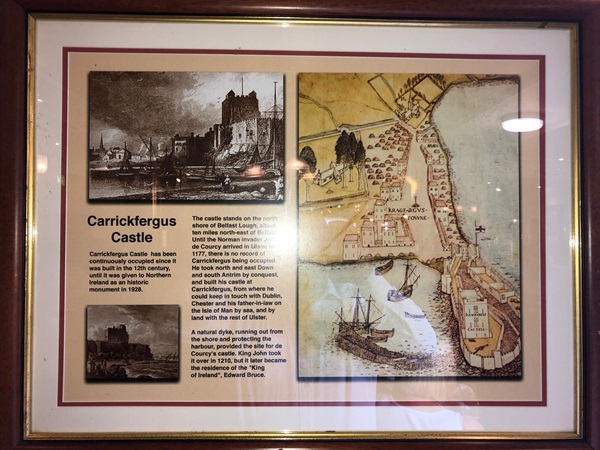
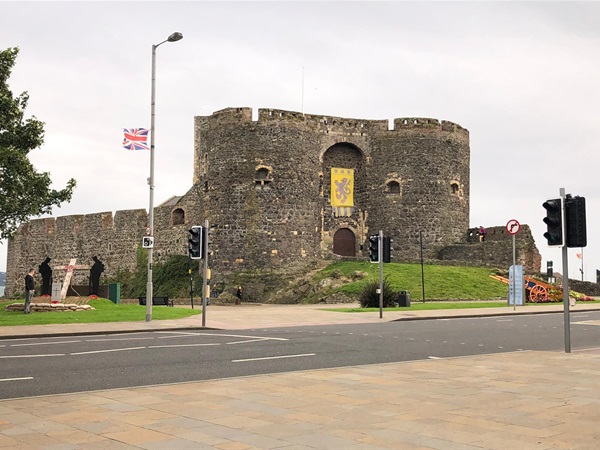
The text reads: Carrickfergus Castle has been continuously occupied since it was built in the 12th century, until it was given to Northern Ireland as an historic monument in 1928.
The castle stands on the north shore of Belfast Lough, about ten miles north-east of Belfast. Until the Norman invader John de Courcy arrived in Ulster in 1177, there is no record of Carrickfergus being occupied. He took north and east Down and south Antrim by conquest, and built his castle at Carrickfergus, from where he could keep in touch with Dublin, Chester and his father-in-law on the Isle of Man by sea, and by land with the rest of Ulster.
A natural dyke, running out from the shore and protecting the harbour, provided the site for de Courcy’s castle. King John took it over in 1210, but it later became he residence of the ‘King of Ireland’, Edward Bruce.
Prints and text about the American connection.
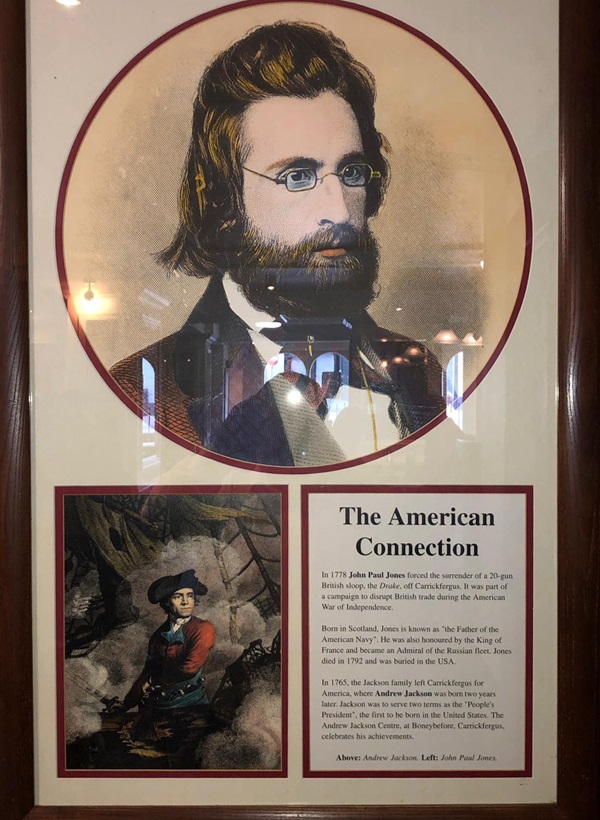
The text reads: In 1778 John Paul Jones forced the surrender of a 20-gun British sloop, the Drake, off Carrickfergus. It was part of a campaign to disrupt British trade during the American War of Independence.
Born in Scotland, Jones is known as the Father of the American Navy. He was also honoured by the King of France and became an admiral of the Russian fleet. Jones died in 1792 and was buried in the USA.
In 1765, the Jackson family left Carrickfergus for America, where Andrew Jackson was born two years later. Jackson was to server two terms as the ‘People’s President’, the first to be born in the United States. The Andrew Jackson Centre, at Boneybefore, Carrickfergus, celebrates his achievements.
Above: Andrew Jackson
Left: John Paul Jones.
Illustrations and text about the history of Carrickfergus.
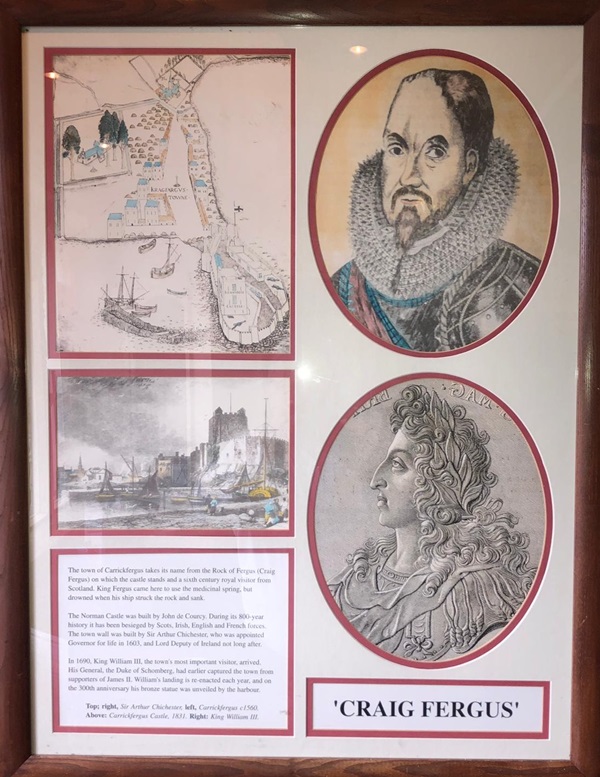
The text reads: The town of Carrickfergus takes its name from the Rock of Fergus (Craig Fergus) on which the castle stands and a sixth century royal visitor from Scotland. King Fergus came here to use the medicinal spring, but drowned when his ship struck the rock and sank.
The Norman Castle was built by John de Courcy. During its 800-year history it has been besieged by Scots, Irish, English and French forces. The town wall was built by Sir Arthur Chichester, who was appointed governor for life in 1603, and lord deputy of Ireland not long after.
In 1690, King William III, the town’s most important visitor, arrived. His general, the Duke of Schomberg, had earlier captured the town from supports of James II. William’s landing is re-enacted each year, and on the 300th anniversary his bronze statue unveiled by the arbour.
Top: right, Sir Arthur Chichester, left, Carrickfergus 1560 Above: Carrickfergus Castle, 1831
Right: King William III.
Prints and text about rebels and allies.
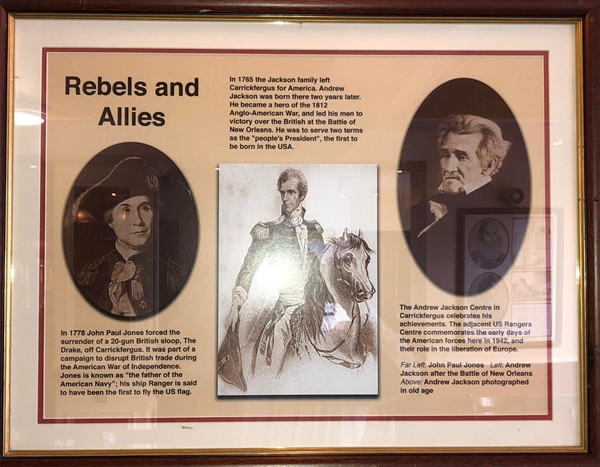
The text reads: In 1765 the Jackson family left Carrickfergus for America. Andrew Jackson was born there two years later. He became a hero of the 1812 Anglo-American War, and led his men to victory over the British at the Battle of New Orleans. He was to serve two terms as the ‘people’s president’, the first to be born in the USA.
In 1778 John Paul Jones forced the surrender of a 20-gun British sloop, The Drake, off Carrickfergus. It was part of a campaign to disrupt British trade during the American War of Independence. Jones is known as ‘the father of the American Navy’; his ship Ranger is said to have been the first to fly the US flag.
The Andrew Jackson Centre in Carrickfergus celebrates his achievements. The adjacent US Rangers Centre commemorates the early days of the American forces here in 1942, and their role in the liberation of Europe.
Far left: John Paul Jones
Left: Andrew Jackson after the Battle of New Orleans
Above: Andrew Jackson photographed in old age.
External photograph of the building – main entrance.
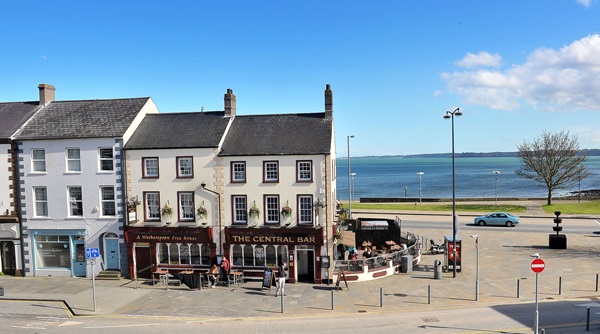
If you have information on the history of this pub, then we’d like you to share it with us. Please e-mail all information to: pubhistories@jdwetherspoon.co.uk